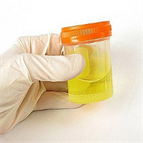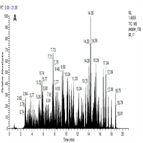Find methods for your needs
Refine by Feature
Displaying 1-4 of 4 results for Tag: TraceFinder
Quantitation of 122 Drugs in Urine by Triple Quadrupole Mass Spectrometry
Instrument Type: LCMSMSForensic toxicologists face an ever-expanding list of compounds for analysis. This note presents work done using a next-generation triple quadrupole mass spectrometer with fast SRM acquisition speed for quantitation of 122 analytes in a single chromatographic run, where scan speed does not impact sensitivity or quantitative performance. Compounds analyzed include opiates, opioids, benzodiazepines, barbiturates, amphetamines, tricyclic antidepressants, illicit compounds, and more. For forensic use only.
Multi-Residue Pesticide Analysis in Herbal Juices using GC-MS/MS
Instrument Type: GCMSMSThe Thermo Scientific™ TSQ™ 8000 Evo triple quadrupole GC-MS is an excellent tool for the control of MRL levels in food commodities. The enhanced velocity optics (EVO) driving EvoCell collision cell technology provide high SRM transition speeds, precision, and sensitivity for even complex methods involving several pesticides in a short run time. This application is focused on the analysis of 247 compounds in two different herbal juices, Aloe vera and Amla (Indian gooseberry), demonstrating the potential of the method to detect trace level compounds at concentrations as low as 1-2 ng/g.
Increased Productivity in Pesticide Residue Analysis – Quantifying 440 Pesticides Following China GB 2763-2014
Instrument Type: LCMSMSHere, a method utilizing the Thermo Scientific TSQ Endura triple quadrupole mass spectrometer and Thermo Scientific TraceFinder software is described for the simultaneous, high-throughput, quantitative analysis of 440 pesticide residues in bell pepper.
Three-Fold Increase in Productivity for Pesticide Residue Analysis in Baby Food Using Fast Triple Quadrupole GC-MS/MS
Instrument Type: GCMSMSIn this study, a fast, easy, and robust workflow was used to analyze pesticide residues in baby food. Accurate and sensitive detection, quantification, and identification of pesticides in baby foods is of particular importance because babies are more vulnerable to adverse health effects from these chemicals.




